Getting Ready: In our learning activities, we will:
- Discuss the meaning of waterborne diseases.
- Discuss the meaning of soil-transmitted diseases.
- Investigate how waterborne diseases are spread.
- Discuss the signs and symptoms of waterborne diseases. We will also discuss the prevention measures for the following diseases:
- Typhoid
- Bilharzia
- Cholera
- Dysentery
- Find out more about ways of preventing the spread of waterborne diseases. We will share this information with other learners, our family members, our friends at home and in school, and people in our communities. In this way, we will develop interest in ensuring good health for ourselves, our families, and our communities.
What we already know
From our studies in Environmental Activities, Home Science and Science and Technology, we already know that personal hygiene is important.
- In what ways do we observe personal hygiene?
- Discuss some of these ways with a partner.
- We also know that it is important to boil and cool water for drinking. Why is that important? Discuss it with a friend.
Activity 2.1: Learn new words
Language link: Learn the meaning of these words:
Waterborne Diseases
Activity 2.2: Develop Interest: What causes diseases?
What are the smallest living things you know? Are they good or bad? In which ways are they bad?
Use the Internet safely to find out the meaning of these words: germs, bacteria and virus.
Learn more. Grow. Share the knowledge with your family and community members
Diseases are caused by germs. Millions of germs are around us. Bacteria and viruses are germs. They are harmful to us.
Bacteria and viruses are very tiny living things. You cannot see them with your naked (unassisted) eyes. Bacteria are everywhere. They are in air, water and soil. They cause diseases such as bilharzia, cholera, typhoid and dysentery.
The germs that cause diseases are spread from one person to another. Germs are also in our food, in our bodies, in our hands, in our clothes, and inside our bodies. They are in urine, in faeces, in mucus and in saliva.
Activity 2.3(a): What is the meaning of contaminated water?
Work safely in groups. Discuss these questions:
- Why is it important to boil drinking water?
- What is the meaning of contaminated water?
- What diseases do people in our community suffer when they drink contaminated water?
- How can we solve problems in our communities: Do people in your community have a source of clean water for domestic use? If not, how can you help to ensure that people do not suffer health problems related to the use of contaminated water? Share your ideas with others.
Activity 2.3(b): Let us find out: What are waterborne diseases?
Activity 2.4: Let us find out how diseases are spread through water
Work safely in groups. Study these pictures. Describe what you see. What problems are shown in the pictures?
How will the people living in these areas be affected if they use the water for drinking, cooking and domestic uses?
What would you advise the community members?
Activity 2.5: What are waterborne and soil-transmitted diseases?
What have you found out? Share your findings with other learners.
Activity 2.6: Finding out how disease-causing germs are spread
Work safely in groups. Study this picture. Discuss what you see.
What causes diseases? How are diseases spread?
Food Safety: How should we handle food safely to prevent the spread of diseases? Share your ideas with members of your family and community.
Learn more. Grow. Share the knowledge with your family and community members.
Waterborne diseases result from using water that is contaminated with disease-causing germs. People suffer waterborne diseases when they bathe, wash or drink contaminated water. They may also get the disease from eating food which has been exposed to contaminated water. Examples of waterborne diseases are cholera, typhoid, bilharzia and dysentery.
Germs are spread from one person to another in various ways. Human faeces and urine are water contaminants.
Soil that is contaminated with disease-causing germs can lead to the spread of diseases. Find out which diseases are transmitted through contaminated soil.
Signs and Symptoms
Activity 2.7: Develop Interest: What are signs and symptoms?
When we discuss diseases, we describe the signs and symptoms. Do these words mean the same thing?
Work safely in groups. Use the Internet to find out the following: What are signs of a disease? What are symptoms of a disease? What does it mean to manage a disease?

The words signs and symptoms are used to describe health-related problems.
Symptoms can only be described by the patient, who feels them. If a patient has pain, no one else may know unless the patient describes how he or she feels. A patient may feel dizzy, tiredness, ringing in the ears or lightheaded.
- Anyone else would not know about these feelings. It is only the patient who can describe them. That does not mean that other people cannot notice when you are unwell.
- When a patient sweats, vomits, or has rashes on the skin, he or she is showing signs of a disease. Signs can be seen and read by a parent, a nurse or a doctor. Signs indicate the presence of sickness.
- Signs are read or seen with the eyes. They can also be sensed by touch or by listening.
- Doctors and nurses also use some type of equipment to read the signs of a disease. What are some of these equipment? What do doctors wear round the neck?
Activity 2.8: Which ones are symptoms? Which ones are signs?

- Heart rate
- Nausea
- Tiredness
- Temperature
- Diziness
- Sweating
- Paleness
- Pain
Managing a Disease
What does it mean to manage a disease?
- Disease management refers to ways in which patients learn to take care of their health. It is about self-care.
- The patient learns to take responsibility for caring for himself or herself when sick.
- The patient learns to avoid exposing himself or herself to risks that could worsen the health problem one is suffering from.
- When we learn how to manage a disease, we share this knowledge with friends, family members and people in the community.
We can prevent and manage diseases by:
- Observing proper sanitation and hygiene.
- Drinking boiled or treated water.
- Washing fruits and vegetables properly with boiled, cooled or treated water.
- Sick people should be taken to hospital where they are isolated and treated.
- Patients who have been treated should take their medicines as advised by the doctor.
Cholera is a waterborne disease
Activity 2.9: Identifying the signs and symptoms of cholera
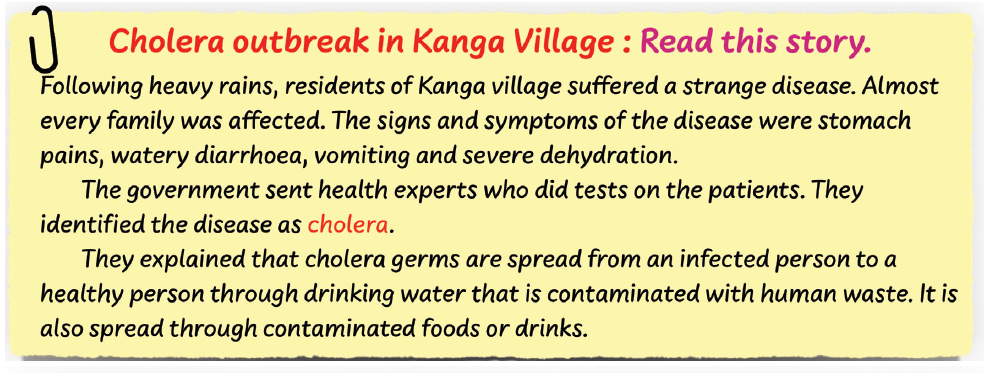
You did coding in Grade 4. The signs and symptoms of cholera mentioned in the story are coded in the simple pictures shown below. Match the signs and symptoms to the given codes.
- Watery diarrhoea
- Dehydration
- Stomach pains
- Nausea and vomiting
Activity 2.10: Complete this activity on cholera
Use the Internet to find out the following:
- What are other signs and symptoms of cholera?
- How is cholera spread?
- How can cholera be prevented?
- How can cholera be managed? Share your findings with your family members and people in your community.
Learn more. Grow. Share the knowledge with your family and community members.
Cholera is caused by germs. The germs are spread through contaminated water. Human waste is a water contaminant. The signs and symptoms of cholera include stomach pains, watery diarrhoea, vomiting and severe dehydration.
Prevention measures include observing proper hygiene, drinking boiled or treated water, and washing fruits properly before eating with boiled, cooled or treated water. Sick people should be taken to hospital where they are isolated and treated.
- Wash hands thoroughly with soap and water before handling foods.
- Boil drinking water to kill germs.
- Keep stored foods covered.
- Wash fruits well before eating.
- Wash vegetables well before cooking.
Study the pictures and statements in the jigsaw shown below. Use them to write sentences that describe some ways of treating and managing cholera.
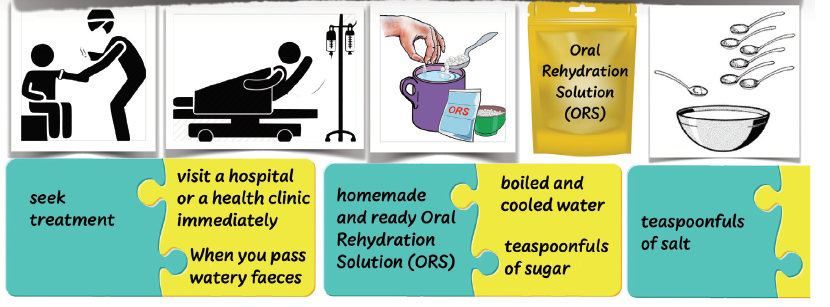
Typhoid is a waterborne disease
- Human faeces with typhoid germs.
- A housefly picks typhoid germs from human faeces.
- The housefly leaves typhoid germs on food.
- A healthy person eats food with typhoid germs.
- How is typhoid spread? Use the Internet safely to find out the signs and symptoms of typhoid.
- In what ways can we prevent the spread of typhoid?
Learn more. Grow. Share the knowledge with your family and community members
Typhoid is caused by germs. The germs are spread through drinking contaminated water and eating food that is contaminated with infected human faeces. Typhoid is also spread through eating raw foods that have been washed in water contaminated with human wastes.
The signs and symptoms of typhoid include stomach pains, diarrhoea, vomiting and skin rashes. Prevention measures include the following:
- Observing proper sanitation and hygiene.
- Drinking boiled or treated water.
- Washing fruits with boiled, cooled or treated water before eating.
Typhoid is managed by taking sick people to hospital where they are treated.
Describe the signs and symptoms of typhoid.
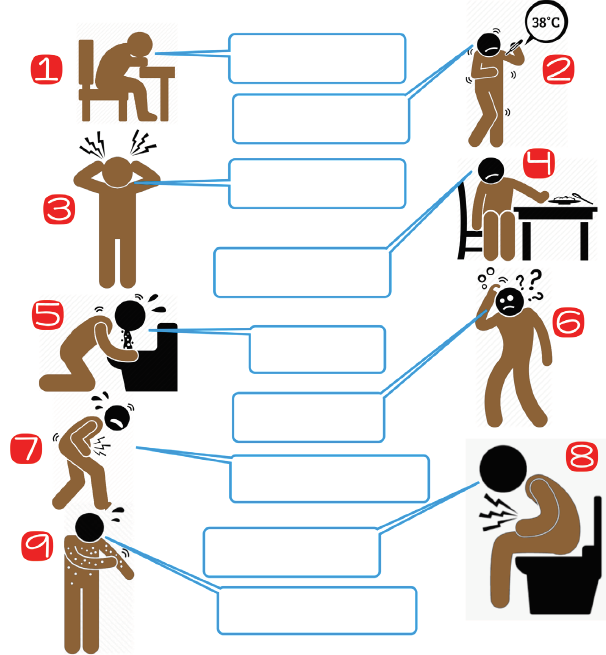
Complete the activity. Use the given words to write complete sentences that describe the signs and symptoms of typhoid.

Bilharzia is a waterborne disease
Activity 2.13: Finding out how bilharzia is spread?
Work safely in groups. Read this story.
Donge went to visit his cousin in Mpunga village. The residents there grow rice in paddies. He assisted the family in planting rice. He did not wear gumboots and gloves, yet he had been warned. A few weeks after he went back home, Donge suffered severe pain in the lower abdomen.
He observed some blood in the urine. His skin developed some red rashes that were itchy.
He went to hospital. The doctor did some tests and discovered that Donge had bilharzia. He was asked if he had swam or walked in stagnant water. He told the doctor about his visit to Mpunga village and how he assisted in planting rice in areas with stagnant water.
The doctor explained that is where he may have contracted the disease. The doctor explained that the germs that cause bilharzia are spread through walking, bathing or swimming in infected stagnant water.
Involve your family.
Serve your community. Ask to find out. Learn. Share. Grow. Solve problems.
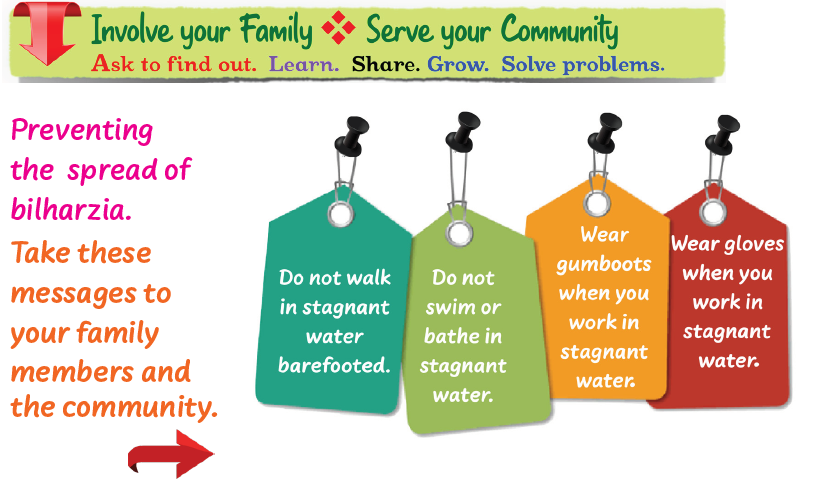
Work safely in groups. Discuss and answer these questions:
- What signs and symptoms of bilharzia did Donge suffer?
- How can you protect yourself from getting infected with bilharzia?
- Use the Internet to find out more about how to prevent the spread of bilharzia. How is bilharzia managed? Share the information with others in your community.
Activity 2.14: The life cycle of bilharzia worms
Work safely in groups. Study this picture.
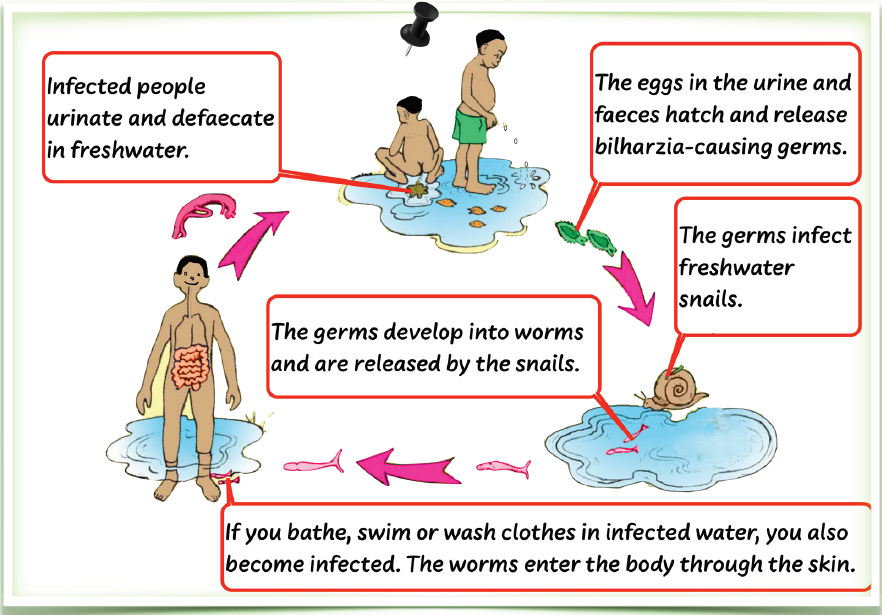
Learn more. Grow. Share the knowledge with your family and community members
Ways of preventing the spread of bilharzia include the following:
- Use the toilet properly.
- Wear protective gear such as gloves and gumboots when working in stagnant water.
- Do not swim in stagnant water or in areas infested with snails.
- Use clean and treated water for washing activities.
- Heat water for bathing. Allow it to cool to prevent burns.
- Educate people in your community on ways to prevent the spread of bilharzia.
Dysentery is a waterborne disease
Activity 2.15: Find out: How is dysentery spread?
Work safely in groups. Use the Internet to research on these questions:
- How does one get infected with dysentery?
- What are the signs and symptoms of dysentery?
- What are the various ways of preventing the spread of dysentery?
- What are the various ways of managing dysentery?
Makim drank water from a pond. Days later, he suffered severe diarrhoea, fever, nausea, vomiting and stomach pains. He went to hospital. Medical tests showed that he had dysentery. The doctor told him that germs that cause dysentery are present in contaminated water, foods and fruits. Washing hands well with soap and water helps to prevent the spread of dysentery.
Learn more. Grow. Share the knowledge with your family and community members
Dysentery is a waterborne disease. The germs that cause dysentery are spread through drinking contaminated water or eating raw foods such as fruits that have been washed in contaminated water.
Dysentery can be prevented by
- Washing hands with clean water and soap before eating and before preparing food.
- Drinking clean and safe water.
- Eating foods prepared in a hygienic environment.
In case of infection, take a lot of fluids such as soups.
Activity 2.16: Messages to take home and to the community
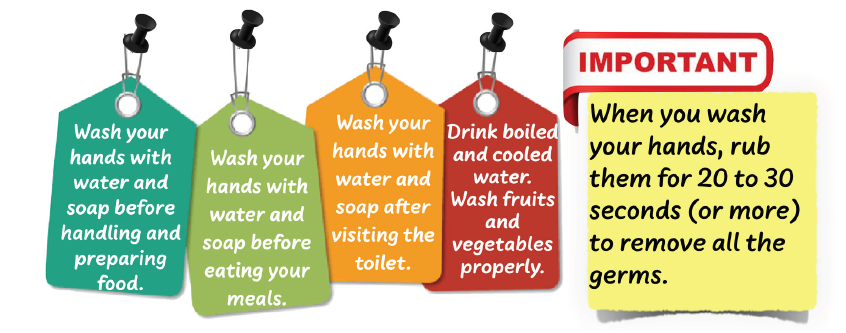
Waterborne diseases are caused by germs found in contaminated water or food. Cholera, typhoid, bilharzia and dysentery are waterborne diseases. Waterborne diseases have similar signs and symptoms.
It is important for a patient to take a medical test to confirm the presence of the disease. The effective way of preventing infection and the spread of waterborne diseases is proper hygiene and the use of protective clothing when working in stagnant water.
Activity 2.17: Complete this activity
Work in pairs. Talk about the chart below. It illustrates the signs and symptoms of dysentery.

Waterborne Diseases: Summary
Involve your family. Serve your community. Ask to find out. Learn. Share. Grow. Solve problems.
Create banners and charts to educate the people in your community about waterborne diseases.
For each waterborne disease, summarise the causes, the signs and the symptoms. Include ways of prevention and management of the diseases. Show your charts to your family and community members.
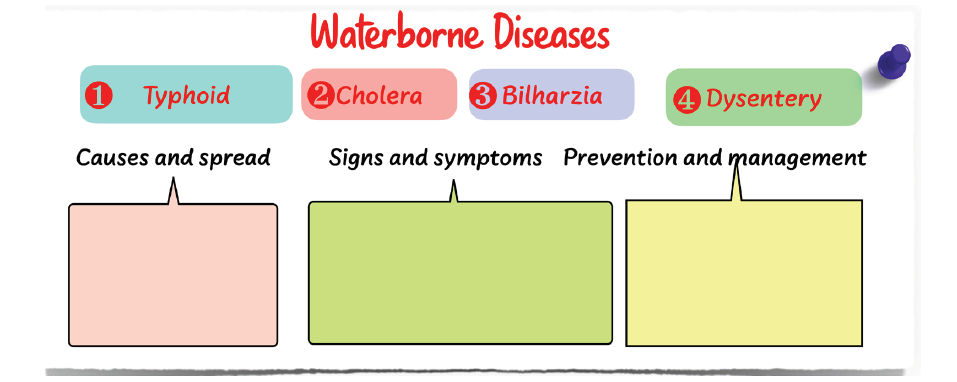
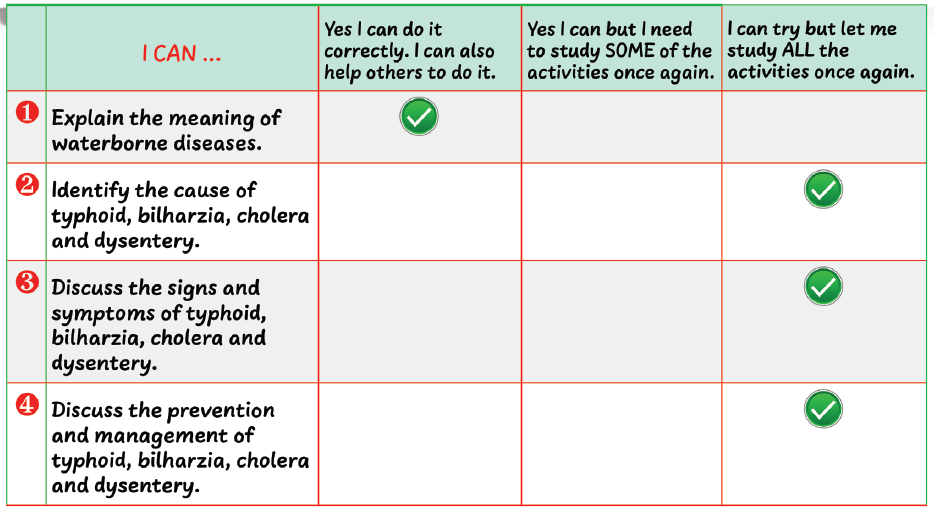
Do the same. Tick columns to check your progress.
